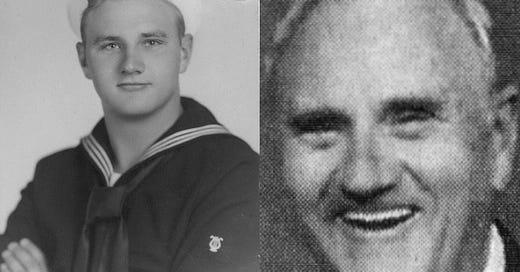Spotlight on John Reynolds from the 1941 Martinsburg High School yearbook
"A blond Apollo with the voice ... that could move mighty mountains with its liquid notes."
As shared over the past couple of weeks here, this 1941 snippet from the Martinsburg High School yearbook offers a glimpse into American youth culture on the cusp of a world-altering decade.
Back in those days, high school students were summarized by pithy one-liners meant to encapsulate their entire personalities in a few short words.
Today, we’re taking a closer look at the second student in the photo, John Reynolds. As a teen, he is idealized by his classmates here as an "Apollo" — evoking masculine beauty, strength, and talent — suggesting high value placed on male charisma and artistic prowess. He's seen as the golden boy or bard. The caption also reflects the era’s fascination with classical beauty and possibly the Golden Age of Hollywood, where male film stars embodied these heroic archetypes. (One of John's great-grandfathers was from Denmark, giving his story a subtle layer of outsider mystique.)
"Johnny" Reynolds was born in Martsinburg, the ninth of 12 children, but he didn't have family roots in West Virginia. His parents were from Rhode Island, descended from ancestors who had settled there and in other parts of the Northeast from northern Europe.
Johnny's father had worked in the woolen mill industry in Rhode Island since his own high-school days. But many years before John was born, his father relocated the family to Martinsburg for a new job opportunity: foreman in the woolen mill industry there.
The family lived at 815 West Virginia Avenue (modern view below), and they filled the small house with music and song. John's mother played piano, and all the siblings grew up singing. (John’s yearbook caption also encapsulated what would indeed become one of the defining traits of his lifetime: his musicality.)
One set of Johnny's great-grandparents were born in Scotland, but another of his great-grandfathers was a native of Denmark. In a region where most families had deep local or Appalachian roots, having Danish ancestry would have made him quietly "other"—not in a negative way necessarily, but enough to set him apart.
That touch of difference -- even if no one knew consciously about his heritage -- may have enhanced his allure, making him seem more cosmopolitan or refined.
If Johnny found love in Martinsburg, it didn't last. The love of his life turned out to be a Rhode Island girl he met as a teenager while visiting family in that state. He married Barbara Appleby on December 13, 1941, just before he shipped out to serve with the U.S. Navy during WWII. During the war, he received a degree from the Navy School of Music in Washington, D.C. For six years, he sang and played flute, piccolo and saxophone with the Navy Band.
As a young adult, he returned to his family's native Rhode Island, although he was stationed twice in Florida and quickly grew enchanted with the Sunshine State. He and his wife and their three children "performed as the Reynolds Family for charities, churches and clubs across New England."
After a brutal Rhode Island winter in 1956, however, the family moved permanently to St. Petersburg, Florida, known as “The Sunshine City.” Johnny and Barbara both got jobs at Christ United Methodist Church in the heart of downtown.
Barbara conducted the children's choir, and Johnny served as the church's assistant music director and then director. While at the church, "he founded a Saturday Night Concert Series for the community that featured guest soloists and choirs from across the country." He also served as conductor for the St. Petersburg Male Chorus.
Johnny's parents moved on from Martinsburg, too, and retired in Florida. Several of John's siblings also moved to Florida. Johnny died of cancer in St. Petersburg in 2003 at age 80 and is buried at Bay Pines National Cemetery.
His obituary earned a prominent spot in the St. Petersburg Times newspaper. He “led St. Petersburg in song,” is how the writer summarized John’s life.
Coming up in They Lived in Berkeley County
May 6: An overview of this series
Last week (May 13): Catherine Rentch’s family history and what became of her after high school
Today (May 20): John Reynolds’ family history and what became of him after high school
Next week (May 27): Bill Rife’s family history and what became of him after high school









What a creative way to study an individual, but also a community and moment in time!
What a wonderful profile! High school yearbooks are such rich treasures and I love the ways in which you illustrated his story.